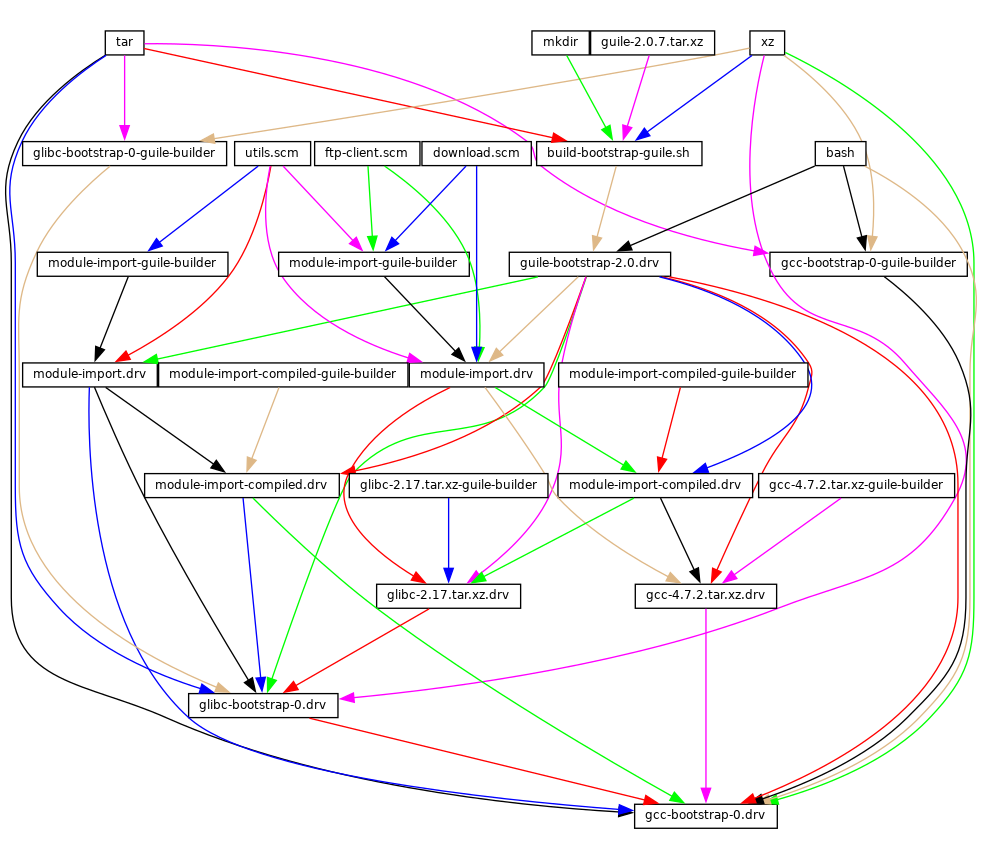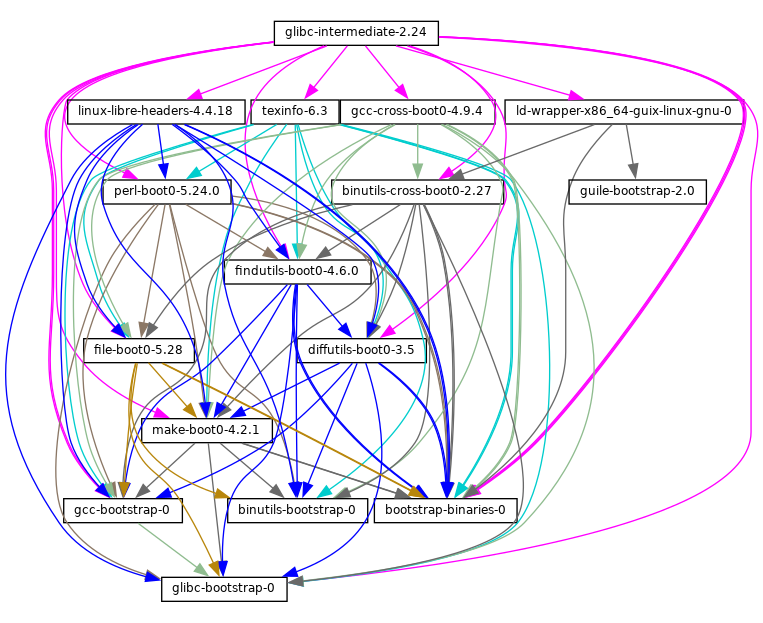20.2 Preparing to Use the Bootstrap Binaries

The figure above shows the very beginning of the dependency graph of the
distribution, corresponding to the package definitions of the (gnu
packages bootstrap) module. A similar figure can be generated with
guix graph (see Invoking guix graph), along the lines of:
guix graph -t derivation \
-e '(@@ (gnu packages bootstrap) %bootstrap-gcc)' \
| dot -Tps > gcc.ps
or, for the further Reduced Binary Seed bootstrap
guix graph -t derivation \
-e '(@@ (gnu packages bootstrap) %bootstrap-mes)' \
| dot -Tps > mes.ps
At this level of detail, things are slightly complex. First, Guile itself
consists of an ELF executable, along with many source and compiled Scheme
files that are dynamically loaded when it runs. This gets stored in the
guile-2.0.7.tar.xz tarball shown in this graph. This tarball is part
of Guix’s “source” distribution, and gets inserted into the store with
add-to-store (see 仓库).
But how do we write a derivation that unpacks this tarball and adds it to
the store? To solve this problem, the guile-bootstrap-2.0.drv
derivation—the first one that gets built—uses bash as its
builder, which runs build-bootstrap-guile.sh, which in turn calls
tar to unpack the tarball. Thus, bash, tar, xz,
and mkdir are statically-linked binaries, also part of the Guix
source distribution, whose sole purpose is to allow the Guile tarball to be
unpacked.
Once guile-bootstrap-2.0.drv is built, we have a functioning Guile
that can be used to run subsequent build programs. Its first task is to
download tarballs containing the other pre-built binaries—this is what the
.tar.xz.drv derivations do. Guix modules such as
ftp-client.scm are used for this purpose. The
module-import.drv derivations import those modules in a directory in
the store, using the original layout. The module-import-compiled.drv
derivations compile those modules, and write them in an output directory
with the right layout. This corresponds to the #:modules argument of
build-expression->derivation (see Derivations).
Finally, the various tarballs are unpacked by the derivations
gcc-bootstrap-0.drv, glibc-bootstrap-0.drv, or
bootstrap-mes-0.drv and bootstrap-mescc-tools-0.drv, at which
point we have a working C tool chain.
Building the Bootstrap Binaries
Because the final tool chain does not depend on the bootstrap binaries,
those rarely need to be updated. Nevertheless, it is useful to have an
automated way to produce them, should an update occur, and this is what the
(gnu packages make-bootstrap) module provides.
The following command builds the tarballs containing the bootstrap binaries
(Binutils, GCC, glibc, for the traditional bootstrap and
linux-libre-headers, bootstrap-mescc-tools, bootstrap-mes for the Reduced
Binary Seed bootstrap, and Guile, and a tarball containing a mixture of
Coreutils and other basic command-line tools):
guix build bootstrap-tarballs
The generated tarballs are those that should be referred to in the
(gnu packages bootstrap) module mentioned at the beginning of this
section.
Still here? Then perhaps by now you’ve started to wonder: when do we reach a
fixed point? That is an interesting question! The answer is unknown, but if
you would like to investigate further (and have significant computational
and storage resources to do so), then let us know.
Reducing the Set of Bootstrap Binaries
Our traditional bootstrap includes GCC, GNU Libc, Guile, etc. That’s a lot
of binary code! Why is that a problem? It’s a problem because these big
chunks of binary code are practically non-auditable, which makes it hard to
establish what source code produced them. Every unauditable binary also
leaves us vulnerable to compiler backdoors as described by Ken Thompson in
the 1984 paper Reflections on Trusting Trust.
This is mitigated by the fact that our bootstrap binaries were generated
from an earlier Guix revision. Nevertheless it lacks the level of
transparency that we get in the rest of the package dependency graph, where
Guix always gives us a source-to-binary mapping. Thus, our goal is to
reduce the set of bootstrap binaries to the bare minimum.
The Bootstrappable.org web site lists
on-going projects to do that. One of these is about replacing the bootstrap
GCC with a sequence of assemblers, interpreters, and compilers of increasing
complexity, which could be built from source starting from a simple and
auditable assembler.
Our first major achievement is the replacement of GCC, the GNU C Library and
Binutils by MesCC-Tools (a simple hex linker and macro assembler) and Mes
(see GNU Mes Reference Manual in GNU Mes, a Scheme interpreter
and C compiler in Scheme). Neither MesCC-Tools nor Mes can be fully
bootstrapped yet and thus we inject them as binary seeds. We call this the
Reduced Binary Seed bootstrap, as it has halved the size of our bootstrap
binaries! Also, it has eliminated the C compiler binary; i686-linux and
x86_64-linux Guix packages are now bootstrapped without any binary C
compiler.
Work is ongoing to make MesCC-Tools and Mes fully bootstrappable and we are
also looking at any other bootstrap binaries. Your help is welcome!

